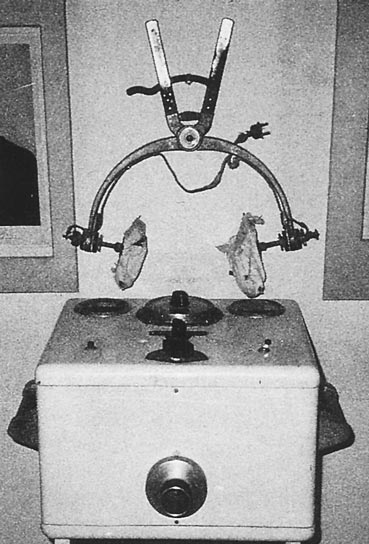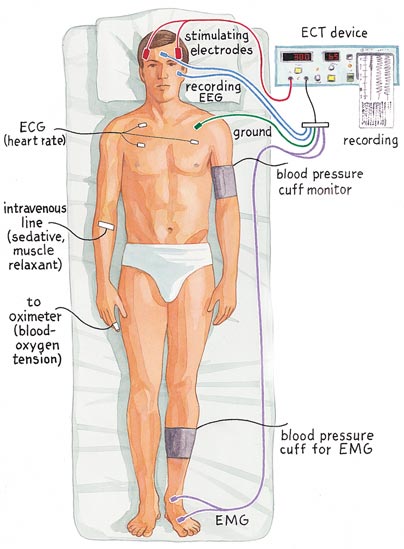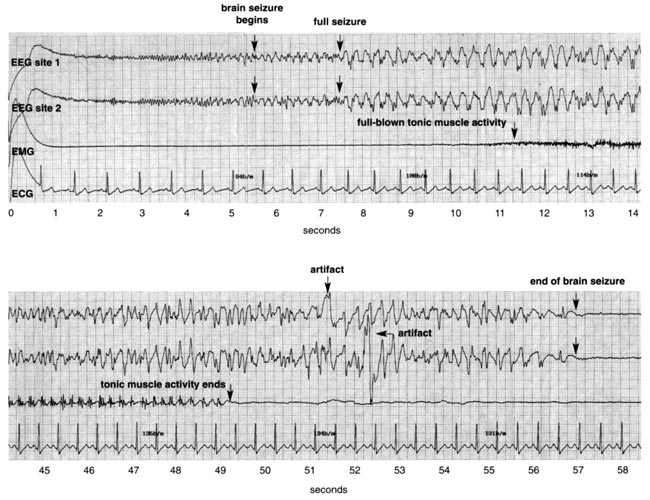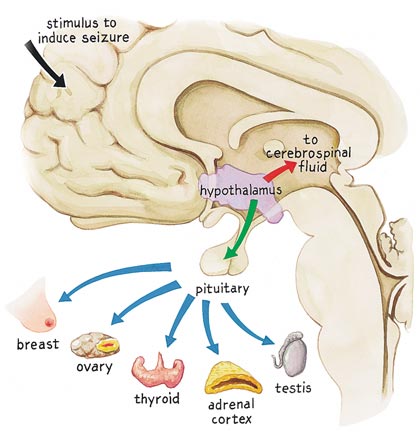Electroshock Revisited
By Max Fink
Electroconvulsive therapy, once vilified, is slowly receiving greater interest and use in the treatment of mental illness
Electroconvulsive therapy, once vilified, is slowly receiving greater interest and use in the treatment of mental illness

DOI: 10.1511/2000.19.162
Scene: The winter of 1934, inside a state hospital for the mentally ill at Lipotmezö, Hungary.
Zoltan, a 30-year-old Budapest laborer, lay rigidly in a bed, staring into the distance. Except for his slow and regular breathing, he appeared lifeless. He had hardly spoken or cared for himself in more than four years. His mental condition of catatonic schizophrenia was considered hopeless. No remedy was available and none was sought; the doctors believed the illness to be an immutable genetic fault. At 10:30 on the morning of January 24, 1934, the Hungarian neuropsychiatrist Ladislas Meduna approached Zoltan's bed to inject an oily extract of camphor into his right buttock. Zoltan's heart soon raced, sweat rose on his brow, and he became increasingly fearful. After 45 minutes, his eyes suddenly closed, his jaw clenched, his breathing stopped, and he lost consciousness. With a deep, noisy sigh, his arms and legs extended, he convulsed, and his bed thumped rhythmically; attendants caught him just before he rolled to the floor. His skin became ashen, and he wet the bed. After 60 seconds, as suddenly as the spasm started, it ended. His eyes opened, and a pink color slowly returned to his cheeks. He continued to stare and was as speechless as before. He had survived an intentionally induced grand mal epileptic fit.
Without any guideline as to how often seizures should be induced, Meduna adopted the schedule used in the popular malarial- fever treatment of neurosyphilis. He injected camphor at three- to four-day intervals, and two days after the fifth seizure, Zoltan awakened, looked about, got out of bed, asked where he was and requested breakfast. He did not believe that he had been in the hospital for four years, and he knew nothing of the intervening history. Later that day, he again relapsed into stupor. After each of the next induced seizures, Zoltan remained alert and interested for longer and longer periods, until after the eighth injection he left the hospital to return to his home and to work. His mental condition of four years was fully relieved. Five years later, when Meduna left Europe for the United States, Zoltan was still well and working at his job.

Tom Dunne
This dramatic account of Zoltan's recovery from schizophrenia describes the first use of the technique that evolved into electroshock, also now called electroconvulsive therapy, or simply ECT. As the modern name suggests, the method now involves the use of electrical currents to induce grand-mal seizures as a treatment for mental illness. Electroshock is applied to about 100,000 patients each year in the U.S., a figure comparable to the number of appendectomies or hernial surgeries performed. Its efficacy and safety has been recognized by the U.S. Surgeon General in his Report on Mental Health, which was released in December 1999. Clinical trials on disorders other than schizophrenia have found ECT to be effective in depression, mania, delusional states and catatonia—in the elderly and in adolescents as well as adults—and it can be safely applied to patients with severe physical illnesses.
Despite electroshock's successes, it is severely restricted by legislation in several states and continues to have an undeservedly poor image in the public mind. Fortunately, there is a growing trend to restore ECT to a reasoned place in psychiatric practice. Here I provide a brief review of the history and present state of electroconvulsive therapy, and some thoughts on its mechanism of action.
Shortly after his success with Zoltan, Meduna treated five other schizophrenic patients—each of whom recovered. Published reports of Meduna's successes galvanized clinicians throughout the world. The notion that dementia praecox (as schizophrenia was then called) could be relieved at all was remarkable to many who believed that the disease was relentlessly progressive and hopeless. Nowadays it is difficult for us to appreciate how revolutionary such an achievement appeared.
Although the camphor-based treatment was successful, it was not without its drawbacks: The injections were painful, and the seizure developed after an agonizing and frightening delay of many minutes. Another chemical, Metrazol, induced a fit quickly when injected intravenously. Within a minute, the patient's thoughts raced, his heart beat rapidly, terror filled the mind, and consciousness was lost. After a few minutes of seizing, the patient slowly reawakened, his muscles, back and head ached, and often his tongue and lips were bleeding. Memory of recent events was erased. Despite the risks and terrors, and the need for repeated frequent injections to achieve a benefit, Metrazol-seizure therapy was widely adopted. Its success changed public and professional attitudes toward mental illness from one of hopeless resignation to optimism that relief was possible.

Photograph courtesy of Max Fink
Ways were sought to reduce the risks of chemically induced seizures. In 1938, the Italians Ugo Cerletti and Luigi Bini induced seizures using electricity applied through electrodes placed on both temples. The seizure was immediate and just as effective as those induced by intravenous chemicals, and the new technique avoided the initial fearfulness and panic. The technique was so easy that within a few years electroconvulsive therapy became the dominant treatment of the severely mentally ill.
The risks persisted, however. The treatments were administered without anesthesia and often resulted in fractures and in severe memory loss. Occasionally, patients suffered a second seizure after leaving the treatment room. The treatments were unpleasant; patients often had to be coaxed, and occasionally forced, to treatment.
Fears of this experience, especially the effects on memory and recall, limited its use. Impaired breathing and the high electrical energies commonly used in the early decades severely impaired the brain's functions. Patients could not recall events during the illness and during the period of treatment. Many lost memories of their early life and were left with feelings of strangeness—that they were living dreams in which much that should be familiar was not.
To reduce the possibility of fractures, the muscle relaxant succinylcholine was routinely made part of each seizure. This relaxed the breathing muscles as well, and to reduce the patient's panic at not being able to breathe normally, a short-acting barbiturate anesthetic became part of the practice. Full oxygenation of the lungs during the treatment became feasible. The electric currents were modified to more physiologically efficient forms. The placement of the electrodes was changed to one side of the head, moving the path of the current away from the memory centers in the brain. These changes in practice reduced ECT's impact on memory.
But as such methods were adopted, patients did not improve as well as before. This was particularly true when practitioners combined one-sided electrode placement with the newer brief-pulse currents. The path of the electric currents affected the treatment's efficacy. To achieve the efficacy of treatments with electrodes on both temples with unilateral placement, it is necessary to deliver stimulating currents of at least five times the strength needed for the brain to seize. Such increased energy achieves greater efficacy, but it is unclear whether the memory-sparing effects of one-sided electrode placement remain. Lately, attention is directed to another memory-sparing maneuver, that of locating the electrodes over the very front of the head. Bifrontal electrode placement elicits effective treatments at near-threshold energies with seemingly little impact on memory.
This panoply of treatment modifications—muscle relaxation, anesthesia, continuous oxygenation, brief-pulse currents, selected electrode placements, energy dosing and monitoring the body's physiology during each treatment—changes the impact of ECT on memory so markedly that when patients now recover from an illness, they are usually able to recall the events that occurred before their illness and to utilize the skills of their education and training with the same ability as others of their age and experience. Patients are able to learn new information as well as they did before they became ill. The events during the illness and the period of treatment do continue to be hazy, although with reminders, some memories are re-established. Despite all these efforts, some patients complain of an undue impact of ECT on memory, and this fear inhibits its broader use.
Public and professional discomfort with the use of electricity, and fear of the effects on a patient's memory, have long fueled the search for a replacement therapy. The most recent offering is the use of magnetic currents to alter brain functions. In 1995, scientists at the National Institute of Mental Health described heightened mood in volunteers after repetitive high-energy transcranial magnetic stimulation of the brain, a technique now identified as rTMS. They applied a device typically used in rehabilitation neurology.
As it stands, however, the physiological affects of these magnetic stimulations are modest. Some authors report that currents applied to electrodes on the scalp stimulate only the superficial layers of the brain. To stimulate the central regions of the brain, much higher energies are needed—and these elicit grand mal seizures. Investigators are now working on issues of safety and technique: How many stimulations? At what frequency? Over which areas of the scalp? At this time, no published study has demonstrated a sustained effect on behavior that matches the benefits of ECT.
The development of psychotropic medicines in the 1950s and 1960s spelled the beginning of a dark period in electroshock's history. The drugs—Thorazine for psychosis, Tofranil for depression, Miltown for anxiety and lithium for mania—ushered in the present era of psychopharmacology. The medicines were easy to administer, carried few immediate risks and were much less expensive. ECT was confined to the dustbin of history.
The political climate in the 1960s and 1970s did little to foster the use of ECT. The new drugs had been lauded for doing away with the large, impersonal state mental hospitals, and the phaseout of the nation's mental-hospital system was in full swing. Their professional staffs had discarded ECT, and it was virtually impossible to re-establish the physical facilities for the treatments or find the trained personnel to carry them out. The nation had been through the political and social upheaval of the Vietnam conflict; the actions of any authority, governmental or medical, were challenged. Legislators were deluged with calls to outlaw what were perceived as coercive psychiatric treatments—psychotropic medicines, electroshock and lobotomy. The California legislature heeded this call in 1973 and banned the use of electroshock and lobotomy. The law was struck down by the courts as an improper incursion into medical practice, but a judicially acceptable bill regulating the treatments became law the next year. It severely inhibits the practice of ECT in that state.
Many public events also cast a pall over the use of electroshock. After a successful senate career, the 1972 vice-presidential candidate Thomas Eagleton was forced from the Democratic ticket when the press trumpeted that he had received this treatment for depression. In the widely hailed 1975 film One Flew Over the Cuckoo's Nest, the protagonist suffers both electroshock and lobotomy at the hands of unbridled caretakers. Viewers leave the theater with sympathy for the patients and hostility to the caretakers. In popular books the psychiatrist Thomas Szasz castigated psychiatrists as agents of the state who coerced the mentally ill into forced and unwelcome hospital care. He especially criticized the use of electroshock. His student, Peter Breggin, canvassed Congress to outlaw the physical treatments of the mentally ill, espousing love and talk therapy as effective agents of change. Ron Hubbard, as part of the mission of his Church of Scientology, unleashed a national attack on psychiatry, which is active today in energizing state legislatures to proscribe psychiatric treatments.
Despite a national climate of outrage and vilification, a few psychiatrists continued to use ECT for patients who had failed treatment with medicines and found that their patients benefited. Reports of such success encouraged manufacturers to improve the treatment devices; scientists again sought ways to improve the practice and reduce the risks; and commissions began to write manuals for proper treatment. By the 1980s, the federal government supported studies of how best to decrease the effects on cognition and memory. Technical improvements emerged quickly, so much so that in its present use ECT is considered as safe as psychotropic medicines. Indeed, for the elderly, for those weakened by systemic diseases and for pregnant women with severe mental illnesses, ECT is safer than the alternative treatments.

Tom Dunne
There is an uneven distribution of facilities providing the treatment. Most university hospitals treat about 5 to 10 percent of their mentally ill adult patients with ECT, whereas the treatment rates at state, federal and Veterans Administration hospitals are much lower because few have the facilities. Community and private hospitals vary widely in their ability to offer the treatment. This results in a haphazard application of ECT.
Legal proscriptions inhibit its proper use. In California, Texas and Tennessee, electroshock is interdicted in children and young adolescents. The legislatures in Arizona, Vermont and Texas have been considering restrictive legislation. In some states, patients may only be treated with electroshock after physicians and independent consultants certify that all other methods of treatment have been tried and failed, an impossible standard to satisfy, consigning the mentally ill to long periods of illness before an effective treatment is given. At times, the treatment is offered too late, the patients having died by suicide or inanition while awaiting court approval for treatment.
Why are seizures, which are dangerous and damaging when they occur spontaneously, beneficial when induced experimentally? For the moment scientists have no answer to this question—we simply don't understand how ECT has the restorative capacity that it does. For that matter, no hypothesis for the mode of action of any psychiatric treatment—be it electroshock, psychotropic medicines or the "talk" psychotherapies—is satisfactory.
Explanations for the mechanism of ECT tend to be similar to those used to explain the therapeutic actions of the psychoactive drugs. Most commonly the explanations are focused on the messenger molecules, or neurotransmitters, that pass from one neuron to another. Among the more notable of these molecules are dopamine, serotonin, norepinephrine and gamma-amino-butyric acid (GABA)—neurotransmitters that are typically central to biologically based theories of mental illness. Each of these molecules binds to specific receptors on neuronal-cell surfaces and in turn modifies the activity of these neurons. Psychotropic medicines alter the concentrations of these neurotransmitters and so modify the activity of neurons in certain parts of the brain, most notably those areas believed to play important roles in mental disorders. How the activity of these neurons translates into thoughts and feelings is the big question now facing neuroscientists.
There is a fundamental difficulty with extending the neurotransmitter-based hypotheses to the mechanism of electroshock, however—one that goes beyond the question of how these messenger molecules play a role in the brain. Experiments involving seizures induced in animals and people reveal that so many neurotransmitters are released in what appears to be a random way that it is difficult to construct a cogent theory.

Another theory of electroshock's mechanism involves the observation that the threshold needed to induce a seizure rises during the course of a successful series of treatments. After anesthesia, it is possible to stimulate the brain with different dosages of electric current. By selecting currents that are too low to elicit a seizure and repeating this procedure with incremental energies, a seizure threshold can be defined as that amount of energy that is sufficient to elicit an effective grand mal seizure. If the seizure threshold is defined in subsequent treatments, we observe a gradual rise in seizure threshold. If the energies are kept constant, the duration of the elicited seizure falls. In successful courses of treatment, seizure thresholds are known to rise. The rise in seizure threshold varies with the rise in cerebral blood flow, slowing of EEG frequencies and the antidepressant effects of electroshock.
Some authors conclude that the antidepressant efficacy of electroshock is related to the anticonvulsant activity of repeated seizures, as reflected in the rise in seizure threshold. The anticonvulsant theory is also encouraged by the efficacy of anticonvulsant medicines in relieving mania. However, the theory is weakened by the failure of antidepressant drugs to raise seizure thresholds and the inability of benzodiazepines (anxiolytics such as diazepam) and other anticonvulsant drugs to elicit clinical antidepressant activity.
Despite their weaknesses, theories based on neurotransmitters, their receptor molecules and the anticonvulsant activity of electroshock have the most support today.
There is, however, an alternative hypothesis. We know a great deal about what we must do to achieve ECT's clinical benefits. Seizures induced by chemicals are just as effective as those induced by electricity, indicating that electricity is not essential to our explanation. Neither anesthesia nor the electric current alone nor a single seizure is effective. At one time, memory impairment was an explanation for electroshock's effects, but we now achieve clinical efficacy without memory impairment and conclude that memory loss is not in the therapeutic chain.
We also know that ECT is very broadly effective in relieving mental disorders. It relieves depressed and manic moods, thought disorders and the motor disorders of catatonia and parkinsonism with almost equivalent efficacy. The most effective forms of ECT are those that directly stimulate the structures in the middle of the brain, as evidenced by the path of the electric current. What can we make of these observations? Whatever the mechanism involved, it appears to affect a broad range of systems in the body. And the central parts of the brain seem to play a key role in modulating electroshock's benefits.

This train of thought leads us to the hypothalamus, a region deep in the brain that is known to be involved in the expression of emotions and that has a profound control over the rest of the body through its actions on the pituitary gland. The hypothalamus, the pituitary and the pineal glands in the brain produce peptides that circulate in the bloodstream and the cerebrospinal fluid, affecting other glands in the body (including the thyroid, parathyroid, adrenal, pancreas, ovaries and testes) and other parts of the brain.
The importance of the hypothalamus in mental illness is consistent with the observation that hormonal functions in the mentally ill are wildly disordered. In the severely depressed, the adrenal glands produce too much cortisol, whereas the hypothalamus is inhibited in the release of its hormones and the pituitary functions are chaotic. During a seizure, massive amounts of the brain's hormones are released into the cerebrospinal fluid and into the bloodstream. How could such a release relieve mental disorders?
Consider the following scenario. Each electroshock stimulus is focused on the hypothalamus, eliciting an immediate and large discharge of its hormones. In the ensuing cascade of hormonal effects, the pituitary gland discharges its products, and those, in turn, alter the discharge of cortisol from the adrenal glands. The first effects of the brainstem stimulations are transitory, but by the fourth or fifth stimulus, the normal feedback actions of the hormones of the hypothalamic-pituitary-adrenal axis are again in place. Feeding and sleep become normal, and improvements in motor activity, mood, memory and thought follow quickly.
In treating the mentally ill, the improved endocrine functions persist after a course of treatment, and the patient remains well. At other times, the glands quickly revert to their abnormal activities, and the mental disorder is again evident. In such cases, continuation ECT is needed to sustain normal glandular functions and a normal mental state.
How the rush of hormones resets the endocrine balance is not known. I propose that the brain secretes a hormone-like substance that regulates mental functions. Unfortunately, research into such a relation is not encouraged by government agencies, which are wary of the public's apprehension toward electroshock. The pharmaceutical industry tends to follow a safe course of finding "me-too" substances that can be marketed, and academic leaders often perceive ECT research as academically incorrect. Nevertheless, the broad efficacy of electroshock warrants greater attention to its therapeutic mechanism and to a campaign of education that will encourage its use for the many mentally ill who are poorly served by other therapies.
Click "American Scientist" to access home page
American Scientist Comments and Discussion
To discuss our articles or comment on them, please share them and tag American Scientist on social media platforms. Here are links to our profiles on Twitter, Facebook, and LinkedIn.
If we re-share your post, we will moderate comments/discussion following our comments policy.